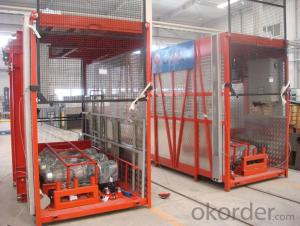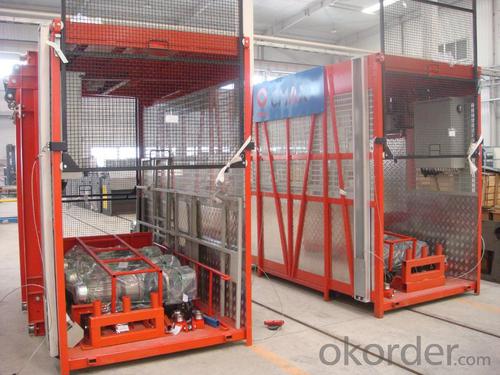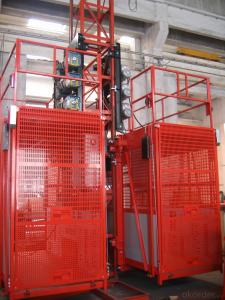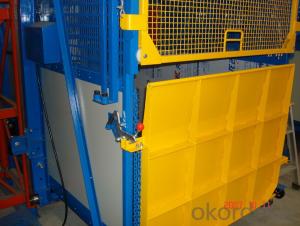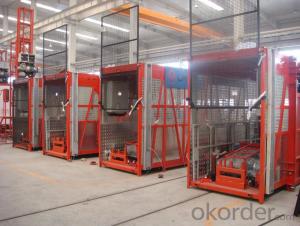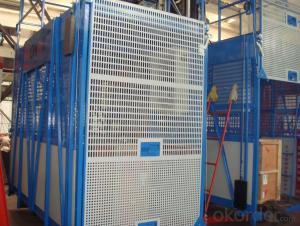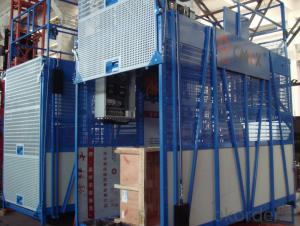construction hoist / builder's hoist/building hoist/SC200/200-10
- Loading Port:
- Tianjin
- Payment Terms:
- TT OR LC
- Min Order Qty:
- 1 unit
- Supply Capability:
- 100 unit/month
OKorder Service Pledge
Quality Product, Order Online Tracking, Timely Delivery
OKorder Financial Service
Credit Rating, Credit Services, Credit Purchasing
You Might Also Like
CMAX BUILDING HOIST SC200/200
DOUBLE CAGES
MAX LOADING CAPACITY= 2X2 T
CAGE SIZE= 3X1.5X2.5 M
MOTOR POWER= 2X3X11KW
MAST SECTION SIZE= 650X650X1508 MM
MAST SECTION & ATTACHED FRAME
TYPE OF SAFETY DEVICE: SAJ40-1.2 ADOPT HOT GALVANIZING PROCESSING
WITH OVERLOAD LIMITER & ALARM SYSTEM
- Q: How does the construction lift fall without electricity
- Pull the manual release (or pedal release) to loosen the electric motor to loosen the brake, the lift will fall, and the speed localizer will die. It's not that professionals don't try "very dangerous"
- Q: This question asks for a comparison between electric and manual lifting equipment, highlighting their distinct features and operational differences.
- <p>Electric lifting equipment, such as electric hoists and cranes, operates using electrical power and is designed for heavy-duty lifting and repetitive tasks. It offers high efficiency, ease of use, and often requires less physical effort from operators. On the other hand, manual lifting equipment, like levers, pulleys, and manual hoists, relies on human power and is typically used for lighter loads or in situations where electrical power is not available. Manual equipment is generally more portable and requires no power source, but it is slower and more labor-intensive. Electric equipment is more suitable for industrial settings, while manual equipment is often used in smaller-scale operations or for temporary tasks.</p>
- Q: Is it possible to integrate a single-rope lifting mechanism into an electric-hydraulic lifting system?
- <p>Yes, a single-rope lifting system can be used in an electric-hydraulic lifting system. The electric-hydraulic system provides the power to lift and lower the load, while the single-rope system manages the vertical movement of the load. This combination allows for precise control and can be advantageous in applications requiring both the lifting capacity of hydraulics and the simplicity of a single-rope system. However, the design must ensure compatibility between the mechanical and hydraulic components to function effectively and safely.</p>
- Q: Is it possible to utilize a single-rope lifting system in both indoor and outdoor environments, especially during cold weather?
- <p>Yes, a single-rope lifting system can be used both indoors and outdoors, including in cold weather conditions. However, it's crucial to consider the specific requirements and limitations of the system and the environment. Cold temperatures can affect the strength and flexibility of the rope, as well as the performance of other components like motors and hydraulic systems. It's essential to use appropriate materials designed for low-temperature operation, ensure proper maintenance, and follow safety guidelines to prevent damage or accidents. Always consult the manufacturer's recommendations for operating in extreme weather conditions.</p>
- Q: This question asks for the method to determine the maximum weight that a building hoist can safely lift.
- <p>To calculate the weight limit of a building hoist, you must consider several factors: the hoist's mechanical capacity, the strength of the supporting structure, the load-bearing capacity of the cables or chains, and the safety regulations in place. Start by checking the manufacturer's specifications for the hoist's maximum load capacity. Then, ensure the hoist's supporting structure can withstand the weight and the force exerted during lifting. Inspect the cables or chains for any signs of wear and ensure they meet the required strength standards. Finally, adhere to local safety regulations, which often mandate a safety factor below the hoist's rated capacity to prevent overloading. Always consult with a professional engineer or the hoist manufacturer for precise calculations and safety guidelines.</p>
- Q: 6 layer of brick and concrete construction project, have tower crane still need construction elevator?
- Tower crane is used for heavy lifting, long pieces, small machinery and materials must be used in the construction elevator.
- Q: Where is the location of the elevator in the project
- Hard to answer, I think should combine the construction plan, adjacent to roadway facilitate material transport, and combining with the construction progress, do not put in sample area, in addition to combined with the construction interface classification and so on into consideration, to say.
- Q: This question asks about the various types of control systems used in building hoists, which are essential for the safe and efficient operation of construction elevators.
- <p>There are several types of building hoist control systems that ensure the safe and efficient operation of construction elevators. These include: 1. Manual Control Systems: Operated by a human operator who controls the hoist's movement. 2. Semi-Automatic Control Systems: Combine manual operation with some automated features, like automatic level selection. 3. Fully Automatic Control Systems: Completely automated, with the hoist moving between floors without manual intervention. 4. Microprocessor-Based Control Systems: Utilize advanced microprocessors for precise control and monitoring. 5. PLC-Based Control Systems: Use Programmable Logic Controllers for robust and customizable control. 6. Wireless Control Systems: Enable remote operation and monitoring of the hoist. Each system has its advantages and is chosen based on specific project requirements, safety standards, and budget considerations.</p>
- Q: Explain the differences between electric and electric-hydraulic lifting equipment, highlighting their mechanisms and applications.
- <p>Electric lifting equipment operates on electric motors that directly drive the lifting mechanism, such as in electric hoists or cranes. This type of equipment is known for its simplicity, low maintenance, and precision control. On the other hand, electric-hydraulic lifting equipment uses an electric motor to power a hydraulic pump, which in turn moves hydraulic fluid to operate the lifting mechanism. This type is characterized by high lifting capacity, smooth operation, and the ability to handle heavy loads. Electric-hydraulic systems are often used in applications requiring significant force, such as in heavy machinery and construction equipment.</p>
- Q: What is the capability of a building hoist in terms of lifting large objects?
- <p>Yes, building hoists are designed to lift and transport large objects in construction settings. They have a high load capacity, often ranging from several hundred to several thousand kilograms, depending on the model and specifications. Building hoists are equipped with safety features to ensure secure lifting and are commonly used for moving materials such as cement, bricks, and heavy equipment within multi-story buildings under construction. However, it's crucial to adhere to the manufacturer's guidelines regarding weight limits and safety protocols to prevent accidents.</p>
Send your message to us
construction hoist / builder's hoist/building hoist/SC200/200-10
- Loading Port:
- Tianjin
- Payment Terms:
- TT OR LC
- Min Order Qty:
- 1 unit
- Supply Capability:
- 100 unit/month
OKorder Service Pledge
Quality Product, Order Online Tracking, Timely Delivery
OKorder Financial Service
Credit Rating, Credit Services, Credit Purchasing
Similar products
Hot products
Hot Searches
Related keywords
